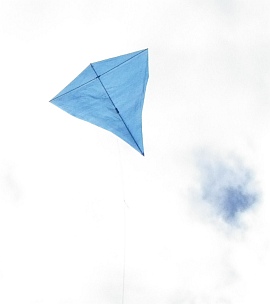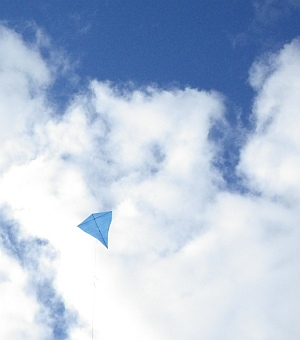- Home Page
- Flight Reports
- Sticked Diamonds
- Multi-Dowel Diamond
Multi-Dowel Diamond Kite
Most Unwilling to Come Down!
This day proved quite ideal for the newly constructed Multi-Dowel Diamond kite. At the field, the story told by the nearest two online weather stations seemed to be borne out. There were fairly light winds that were gusting into the gentle range—up to around 19 kph, that is.
 MBK Multi-Dowel Diamond
MBK Multi-Dowel DiamondDue to the wind direction, a short walk to the opposite side of the reserve was necessary. As is my custom, the bag of kiting odds'n'ends was placed near the foot of a tree along with the trusty hose-reel winder.
The same line is used for all the Multi-Dowel kites—200-pound braided Dacron. For this diamond, that would be overkill in
terms of strength. But it only takes a couple of kilos of tension to
pull most of the sag out of the line while the kite is in flight.
Setup was easy, as it is for most diamonds. Being a large tailless design, this one is just as easy to launch as a delta too. However, staying up was not so easy today!
As
often happens, longer and longer line lengths were tried, to pull the
kite up into faster air. Finally, 150 feet of length proved
sufficient.
A bit of fun was had, hovering the kite over the
one spot at about 1 meter (3 feet) above ground while backing away
upwind and letting out line. Just past the 45 meter (150 feet) marking, I
gripped the line to initiate a climb.
After jogging upwind for just a few steps, the kite bit into 5 to 10 kph of breeze and continued to climb on its own.
On this site, there's more kite-making info than you can poke a stick at. :-) Want to know the most convenient way of using it all?
The Big MBK E-book Bundle is a collection of downloads—printable PDF files which provide step-by-step instructions for many kites large and small.
That's every kite in every MBK series.
The wind direction and time of day were similar to the ill-fated KAP session of a few days ago. On that occasion, the kite tended to fly directly through the sun, from my perspective. However, cloud cover was heavier today, which resulted in much less glare when photographing in that direction.
Although no thunderstorm activity was forecast, I was still a little uneasy due to the enormous extent of the rain cloud directly overhead! After a while it seemed to blot out half the sky. No rain fell at all although the grass was damp from a previous shower.
The ominous region of gray did not appear to be moving downwind, either. Perhaps it was still growing in all directions! Or maybe not, since this locality sometimes has complex wind patterns. There's the influence of the sea on one side and a range of hills on the other.
The big blue diamond appeared a little out of trim, so I took it down and shifted the knot on the upper bridle loop by a centimeter (1/2 inch) to the right.
The initial rate of climb seemed a little lethargic too, so I moved the other bridle knot toward the nose a little. This would also help prevent the kite from getting overpowered during gusts. It is a light-wind design after all.
With the kite holding height at around 100 feet on 150 feet of line, it was a chance to take some photos. It was a pity about the overall light levels, but what lighting there was, was from almost directly behind the thin plastic sail. This worked out OK.
All of a sudden the Multi-Dowel Diamond kite was pushed overhead by some rising air. Then a small bird with elliptical wings soared past, one or two hundred feet above the kite. The bird was just gliding, evidently seeing no need to flap!
 Up wih the clouds
Up wih the cloudsAround this time, sunlight was coming in and out as thinner portions of the cloud cover moved across.
With
all the camera work out of the way, I cautiously let out some more
line to 60 meters (200 feet). The big diamond still had some hints of
leaning to the left. So it will be necessary to check the horizontal
spar curvature later and file off some wood on one side. Less wood
means more curvature on that side when the bow lines are connected under
tension with the toggle-and-loop.
The leaning problem was quite
minor, so I let out flying line to 75 meters (250 feet) and waited for
the kite to rise back up to its 50- to 60-degree line angle.
By now, the midafternoon air seemed to be smoothing out. The sun had been obscured for more than 10 minutes.
Finally, I let out to 90 meters (300 feet) of line and enjoyed seeing the big diamond sit very steadily
at over 250 feet off the grass. The pointy tail end was shifting left
and right over just several centimeters (an inch or two), which was
barely perceptible at that height. Occasionally, the whole kite would
shift left or right by several meters in response to small changes in
the wind's direction.
For many minutes on end, the Multi-Dowel
Diamond kite just sat there at around 65 degrees of line angle—satisfyingly stable! I suspected that several square kilometers were in
weak lift or at least having multiple regions of lift close together.
As if to confirm my thoughts, three white cockatoos flew past the kite.
The birds didn't flap their wings for the entire width of the reserve before flapping briefly to alight in the massive pine tree across the
road.
The end of my small son's school day was approaching. So it
was time to bring down the kite. Well, I tried, but at 150 feet off the
grass, it simply refused to come down!
At one point the
drop-sheet-plastic sail rustled, and I felt a kilo or two of extra
tension come on the line. This was with the kite vertically overhead! It even
overflew briefly before finally sinking back downwind. But not very far—the big diamond still remained almost overhead until the bridle was
in my hand.
I really could not have asked for more on the first
outing with the Multi-Dowel Diamond kite. Except, that is, for perhaps a bit more
light for better photos! This design seems very comfortable in the 8 kph
to 20 kph range of wind speeds.
The story or stories above document actual flying experiences. My write-ups are definitely "warts and all," since things don't always go totally as planned. However, half the fun of kiting is anticipating the perfect flight. When it happens, it's magic!
As mentioned earlier, there's more kite-making info here than you can poke a stick at. :-)
Want to know the most convenient way of using it all?
The Big MBK E-book Bundle is a collection of downloads—printable PDF files which provide step-by-step instructions for many kites large and small.
That's every kite in every MBK series.
